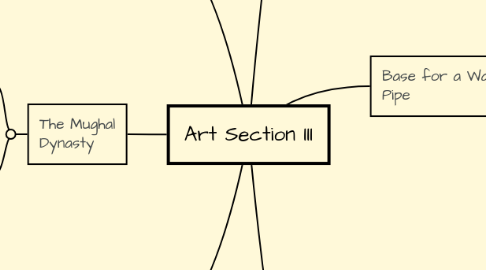
1. The Arrival of Islam in India
1.1. Mailk Dinar
1.2. Cheraman Jum’ah Masjid
1.3. Mahmud of Ghazni expeditions to India
1.4. Muslims generally destroyed the existing religious monuments they encountered
1.5. Mu’izz al-Din Muhammad conquered Delhi
2. The Mughal Dynasty
2.1. Significant Islamic influence in Indian art and culture
2.2. The Mughals were Sunni Muslims
2.2.1. The first Mughal ruler was Babur
2.2.2. Timur established the Timurid Dynasty with the ultimate goal of restoring the empire of his ancestors
2.2.3. Descended from the warlord Timur and Genghis Khan
3. The Emperor Shahjanan Riding
3.1. Persian miniature painting
3.2. Painted in watercolor
3.3. 10 1/3 x 6 3/4
3.4. One handed hold on the reins shows how calmly he rules the people
3.5. Portrait of king on horseback elevates the ruler
4. Indo Persian Carpet With Medallions
4.1. Turkish nomads were the first to create weaved carpets as carpets for their tents and huts
4.2. Carpets are placed in mosques to make kneeling more comfortable
4.3. Made from natural wool and cotton fibers
4.4. It is believed that Akbar introduced carpet production to India in the late 16th century
4.5. Some rugs have as many as 350 knots per square inch
4.6. Analysis
4.6.1. 37 ft x 12 ft
4.6.2. Burgundy, gold, blue, black
4.6.3. Perfectly symetrical
4.6.4. Floral motifs
4.6.5. Central zone of the carpet has three large medallions
5. Base for a Water Pipe
5.1. Tobacco was introduced to India in the 1600s
5.2. In Muslim cultures, metal objects were used by all social classes
5.3. Analysis
5.3.1. Pipe was decorated with foliage elements
5.3.2. 7 ⅝ inches high x 6 ¾ inches diameter
5.3.3. Top of the ball has a flared lip
5.3.4. Two animals are seen on the form
5.3.5. Used to filter tobacco smoke
5.4. Imperial pieces were ornately decorated and made from silver and gold
5.5. Embellishments were produced using an inlaying technique
6. Taj Mahal
6.1. Indian architecture tended to be a fusion of various existing forms (Persian, Islamic, and indigenous Indian)
6.2. The Taj Mahal sits on 55 acres
6.3. Together they had 14 children (seven survived)
6.4. She and Shahjahan were married for 19 years, and she was seen as a charitable and compassionate figure
6.5. The Taj Mahal was built as a tomb for Shah Jahan's wife Mumtaz Mahal
6.6. The tomb structure of the Taj Mahal is set within an elaborate garden
6.7. Architectural sponsorship began with Babur
6.8. Analysis
6.8.1. Mughal structures often included octagonal structures in reference to the eight paradises of the Quran
6.8.2. Name translates to “crown of palaces”
6.8.3. Began construction in 1631 and was finished in 1647
6.8.4. Sits on the banks of the Yamuna River in Agra

